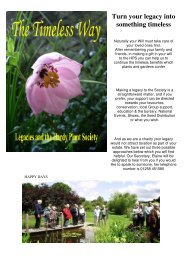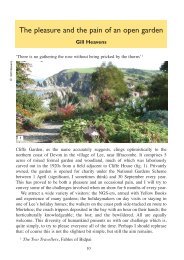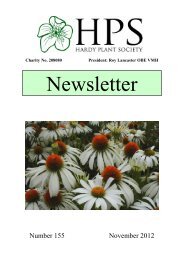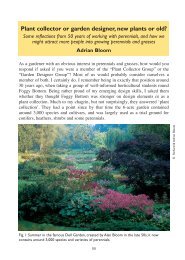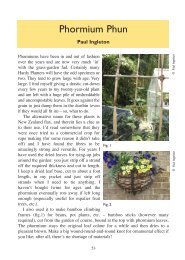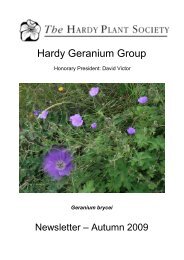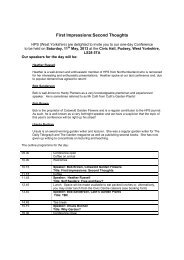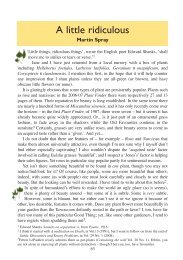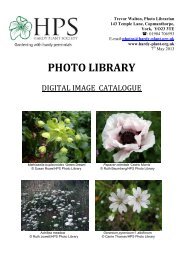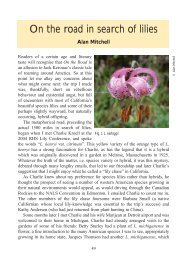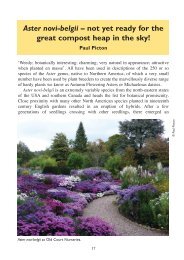Mukdenia - Hardy Plant Society
Mukdenia - Hardy Plant Society
Mukdenia - Hardy Plant Society
You also want an ePaper? Increase the reach of your titles
YUMPU automatically turns print PDFs into web optimized ePapers that Google loves.
014 chapter 9/17/09 11:20 AM Page 1<br />
<strong>Mukdenia</strong><br />
Aileen Stocks<br />
<strong>Mukdenia</strong>. Hardly an inviting name in the English language for what is an<br />
attractive genus, but if you lived in China you would recognize its origin as<br />
Mukden, once the ancestral capital of the Manchu dynasty and the old capital of<br />
Manchuria, now called Shenyang. Its common name is mapleleaf tickfoil.<br />
Originally they were classified as Aceriphyllum, presumably because the shape of<br />
the leaves of M. rossii resemble those of the Acer genus, but now they are<br />
ensconced in the Saxifragaceae family. Native to north east Asia, particularly<br />
north China, Korea and Japan, they are found in light woodland and perform best<br />
in cool, damp summers.<br />
There are two species, M. rossii and M. acanthifolia and both have the usual<br />
characteristics of the family with a rhizomatous root system and a basal rosette of<br />
leaves from which rise panicles of white, starry<br />
flowers in early spring. In appearance they<br />
resemble Darmera but on a much smaller scale.<br />
They are hardy to Zone 4 but do need light<br />
shade and damp, though not waterlogged<br />
conditions. Perennial, they form clumps and<br />
make good ground cover without being<br />
invasive. As with many in this family they will<br />
need a period of dormancy for good growth and<br />
flower production. In most of the UK this will<br />
happen naturally as they will die down in the<br />
winter, but in countries or parts with a more M. acanthifolia<br />
consistently warm temperature all year, flower<br />
production might be inhibited.<br />
Propagation can be by seed sown in autumn<br />
or by dividing the rhizomes in late winter or<br />
early spring. Care should be exercised as the<br />
flowers appear early before the leaves and can<br />
be damaged by late frosts. They are relatively<br />
pest-free apart from slugs and snails attacking<br />
the early leaf growth.<br />
<strong>Mukdenia</strong> rossii – The starry white flowers rise<br />
to 40cms on naked green stems. They are<br />
M. rossii<br />
closely followed by bright green leaves which<br />
59<br />
© Aileen Stocks<br />
© Aileen Stocks
014 chapter 9/17/09 11:20 AM Page 2<br />
can grow to 12cms across and are most attractive, being asymmetrically divided<br />
and plate-like. As the summer wears on, the leaves take on a bronze or reddish<br />
hue, the intensity of colour dependent on the heat.<br />
There are several varieties: ‘Shishiba’ has deeper cut foliage and ‘Karasuba’,<br />
introduced from Japan by Dan Hinkley and known here as ‘Crimson Fans’, has<br />
crimson tips to the leaves all summer.<br />
<strong>Mukdenia</strong> acanthifolia – This has well shaped leaves, similar to Bergenia but<br />
smaller and more refined. Bright green at first, they fade to a buttery yellow in<br />
late summer and autumn. The flower stem is early and carried high above the<br />
fresh rosette of leaves.<br />
The specific name of this <strong>Mukdenia</strong>, namely acanthifolia, rather like the old<br />
name for Bergenia acanthifolia, has me a little perplexed. Neither has leaves that<br />
are ‘pointed’ or ‘thorny’ as the name would suggest, whilst the leaves of M. rossii<br />
do indeed seem to resemble those of the Acanthus. The Bergenia is now known as<br />
Bergenia x spathulata, giving a much more apt description that could equally be<br />
applied to M. acanthifolia. Maybe there is a <strong>Hardy</strong> <strong>Plant</strong>er reading this who will<br />
put me straight. I look forward to the next edition and the answer to my<br />
quandary .<br />
Astilbe, Bergenia & Rodgersia in the Family Saxifragaceae<br />
Aileen Stocks<br />
<strong>Hardy</strong> <strong>Plant</strong> <strong>Society</strong> 64pp £3.00 inc. postage to members<br />
This latest HPS booklet is a part revision of the three<br />
largest genera of Aileen’s original booklet on<br />
Saxifragaceae, published in 1995. In the intervening<br />
years plant breeders and plant hunters have swelled the<br />
list of plants to grow, making it impossible to give a<br />
comprehensive treatment of the family in a single small<br />
volume.<br />
Aileen describes the characteristics and history of each<br />
genus, and gives advice on their suitability for particular<br />
garden positions and on maintenance and propagation. For<br />
each genus there is a comprehensive list of species, hybrids<br />
and cultivars, with brief descriptions. Information on the<br />
National Collections is included.<br />
The book is illustrated with colour photographs by the author<br />
and line drawings by artists Janet Wood and Shirley-Anne<br />
Kennedy.<br />
60



